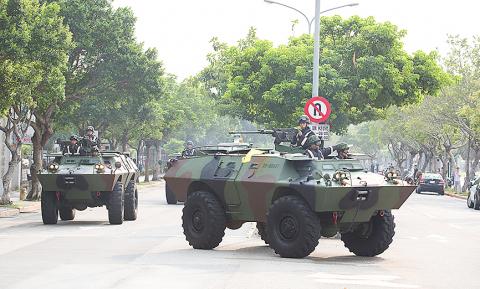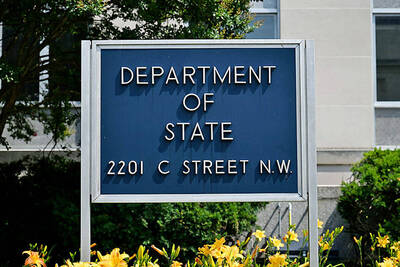The National Security Council is planning a three-day drill this week to test the government’s ability to respond to an emergency, an unnamed senior-level government official said yesterday.
The timing of the drill is to be confirmed in the next few days, after evaluations have been made regarding heavy rainfall over the past few days, the source added.
The purpose of the drill is to practice ensuring the safety of political and military leaders during a military crisis, while maintaining the government’s core functions and protecting critical infrastructure, the source said.

Photo: CNA
The drill is divided into three sections: the activation of the emergency command post and the evacuation of the president, the vice president and other important leaders to the command post; the protection of critical infrastructure; and exercises responding to various scenarios, the source said.
For the latter, the heads of important divisions within the government would act out different scenarios, accompanied by a number of legislators and academics, who would act as officials from Taiwan’s diplomatic allies, the source said.
The results of the drill would be an important reference for adjustments, the source added.
In previous years, the drill has involved practicing how to evacuate the president, vice president and other top officials to the command post using the eight-wheeled CM-32 “Clouded Leopard” armored vehicle — officially known as the Taiwan Infantry Fighting Vehicle, the source said, adding that the council has not yet decided whether to use the vehicle.
For last year’s drill, the council had planned on simulating an ambush on the president and vice president’s motorcade, as well as a scenario in which the president had to call for international assistance during a Chinese military blockade, the source said.
The source did not confirm which scenarios were actually simulated last year.
This year’s security drill would focus on protecting the nation’s critical infrastructure and the government’s emergency response mechanism, the source said.
During the drill, government officials are to travel to either the Yuanshan Command Center or a separate command center in northern Taiwan, the source said, adding that the military would go to the Hengshan Military Command Center, which allows it to monitor Chinese People’s Liberation Army aircraft, vessels and missiles in the Taiwan Strait and surrounding areas.
The military’s command and joint command centers are small, and most of the facilities are old, so the government has decided to build a new office in Taipei’s Dazhi area (大直), where it plans to station supervising officers, the source added.
In related news, the military has reportedly asked units to increase their live-fire training exercises in recent years, resulting in a significant increase in the amount of ammunition used.
The military last year used about 6.8 million more rounds of ammunition for training than in 2016, government statistics showed.

MISINFORMATION: The generated content tends to adopt China’s official stance, such as ‘Taiwan is currently governed by the Chinese central government,’ the NSB said Five China-developed artificial intelligence (AI) language models exhibit cybersecurity risks and content biases, an inspection conducted by the National Security Bureau (NSB) showed. The five AI tools are: DeepSeek, Doubao (豆包), Yiyan (文心一言), Tongyi (通義千問) and Yuanbao (騰訊元寶), the bureau said, advising people to remain vigilant to protect personal data privacy and corporate business secrets. The NSB said it, in accordance with the National Intelligence Services Act (國家情報工作法), has reviewed international cybersecurity reports and intelligence, and coordinated with the Ministry of Justice Investigation Bureau and the National Police Agency’s Criminal Investigation Bureau to conduct an inspection of China-made AI language

LIMITS: While China increases military pressure on Taiwan and expands its use of cognitive warfare, it is unwilling to target tech supply chains, the report said US and Taiwan military officials have warned that the Chinese People’s Liberation Army (PLA) could implement a blockade within “a matter of hours” and need only “minimal conversion time” prior to an attack on Taiwan, a report released on Tuesday by the US Senate’s China Economic and Security Review Commission said. “While there is no indication that China is planning an imminent attack, the United States and its allies and partners can no longer assume that a Taiwan contingency is a distant possibility for which they would have ample time to prepare,” it said. The commission made the comments in its annual

CHECKING BOUNDARIES: China wants to disrupt solidarity among democracies and test their red lines, but it is instead pushing nations to become more united, an expert said The US Department of State on Friday expressed deep concern over a Chinese public security agency’s investigation into Legislator Puma Shen (沈伯洋) for “secession.” “China’s actions threaten free speech and erode norms that have underpinned the cross-strait ‘status quo’ for decades,” a US Department of State spokesperson said. The Chongqing Municipal Public Security Bureau late last month listed Shen as “wanted” and launched an investigation into alleged “secession-related” criminal activities, including his founding of the Kuma Academy, a civil defense organization that prepares people for an invasion by China. The spokesperson said that the US was “deeply concerned” about the bureau investigating Shen

‘TROUBLEMAKER’: Most countries believe that it is China — rather than Taiwan — that is undermining regional peace and stability with its coercive tactics, the president said China should restrain itself and refrain from being a troublemaker that sabotages peace and stability in the Indo-Pacific region, President William Lai (賴清德) said yesterday. Lai made the remarks after China Coast Guard vessels sailed into disputed waters off the Senkaku Islands — known as the Diaoyutai Islands (釣魚台) in Taiwan — following a remark Japanese Prime Minister Sanae Takaichi made regarding Taiwan. Takaichi during a parliamentary session on Nov. 7 said that a “Taiwan contingency” involving a Chinese naval blockade could qualify as a “survival-threatening situation” for Japan, and trigger Tokyo’s deployment of its military for defense. Asked about the escalating tensions